What technologies of computer games are flowing into reality - and a review of technologies in live action games
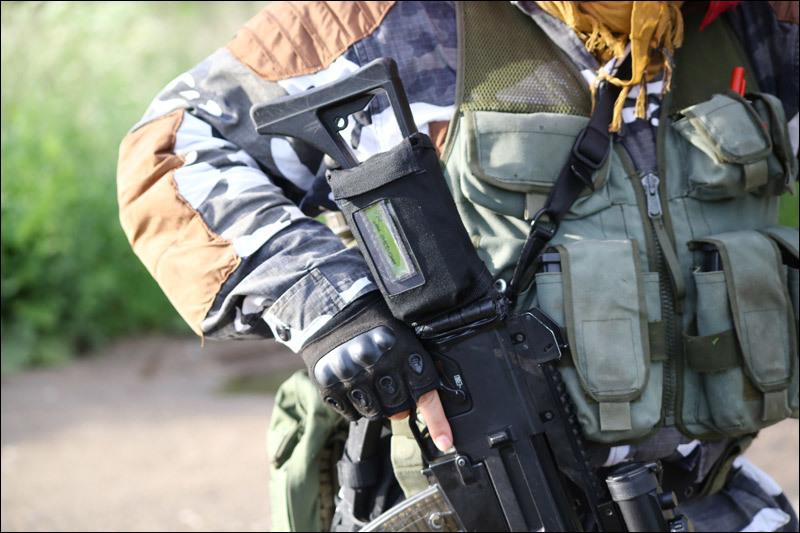
It is quite logical that almost everything that was in computer games got to real ones.
Now you have armor and guns that allow you to accurately count hits (infrared and laser with realistic recharge); Stalker anomaly detectors, which create a new reality in general around the test sites; RFID-locks for quests; different arduino-heaped things and a bunch of weird stuff. In general, they increase the level of realism of the real world and the in-game connectedness of the plot.
')
In general, let's see what technical entourage is currently used in live action games, and what has migrated to the real from shooters and RPGs.
The first technological level is about the 90s
In the field games of the 90s, radio communications were used most actively as the second level of plot connectivity. This is the simplest thing that distinguished the technological game of the “Stone Age” from the ordinary one. At first, radio communication was needed only to coordinate game technicians, but it quickly became clear that radios and receivers can and should become game elements. Especially after someone ordered a radio station for a tank, forgetting to add one small letter in the model name. I had to figure out how to use it. Examples of use are very simple:
- Armstrong was included in Broadcast - and now we have around not Voronezh, but Fallaut.
- Different radio games are going very well, incl. submission of game information in the stream. For example, on one of my games on the air, on a common wave, there was always a leading radio station reading out reports on the progress of the invasion of the planet, plus talks of military detachments were heard on a regular basis. In the later games, there were already special radio operators, who held 5-6 frequencies at once and coordinated the bases.
- Radio gave, in fact, the opportunity to contact without direct participation. For example, on my own “Death Note”, Kira got in touch with journalists through a transmitted radio. When he decided that it was too difficult, and tried through the Internet (the benefit from a dynamic IP would not calculate it), a surprise was waiting for him. Two bottles of beer to the admin provider completely and permanently solved for him the issue of anonymity in Runet.
- And, of course, the walkie-talkie can expand the world of the game by attracting some external characters - like, from here, from Mars, contact Iceland, the biologist Mr. Lennonson - and now igrotec gets up and plays it on the walkie-talkie. Previously, this was done by "telegrams."
Back in the 90s, pyrotechnics was very very widely used. Besides the fact that it was possible to get it from the ensigns (false lights, nuclear explosion simulators, etc.), folk crafts made of gasoline and a bucket went very well. If you have never seen how with the help of a buried gas bucket you can depict the start of a nuclear war on a game about postapocalicis - you missed a lot.
At the end of this period, computers with mini-games began to appear on the grounds. For example, enter the password - they give you a piece of information. Most often, these were simple programs in Pascal, running directly under DOS without any tricks.
A couple of times the guys from Novosibirsk went to the games, who brought traditionally strange things like magic staffs with “scratched” holograms and other equally interesting, but isolated, electronic miracles.
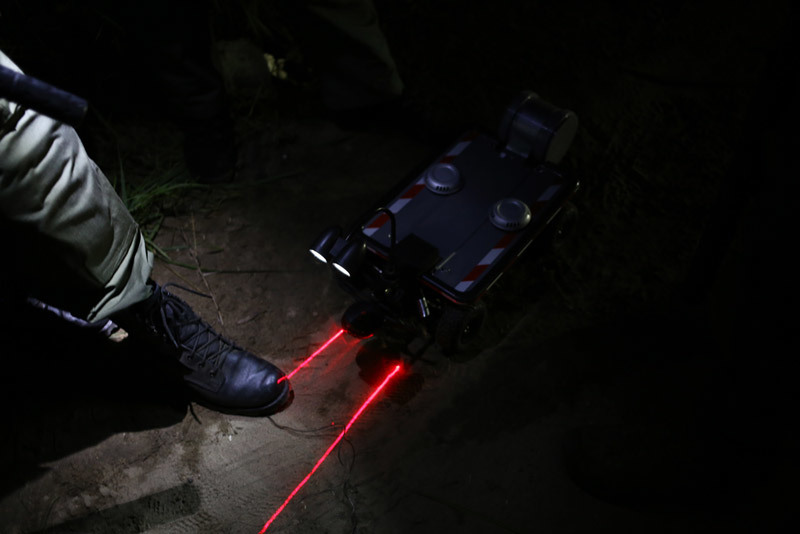
Trolley to remove stretch marks (modern, but corresponding to the time). The creator wanted to screw the camera and infrared LEDs on it. In the meantime, we have limited ourselves to learning how to deliver airsoft grenades without checks on it for two corners.
The second technological level
By the beginning of the two thousandth, they began to spend significantly more on live action games, from hobbies they gradually became sports. Especially noteworthy is the example of a historic Viking village - Scandinavian boys for three weeks plunged a lot of paid tourists into the world of medieval reconstruction. There it was necessary to forge in the smithy, to cook food, to harvest the crop myself - and all this in historically correct ways. Over this is the rich mystery and plot layers. When people got used - closer to the end of the game - an animatronic robot dragon 18 meters in length with a butane lighter in the face came out of the ground. And he began to let the fire in front and behind. Then he scattered a couple of houses on the logs. Then he died heroically at the hands of the local Siegfried.
Nobody expected this, so the raptures were wild. But they did not dare to repeat the game.
At the same time, sensors and various smart devices were put into wide use. With the advent of sound volume sensors, normal volume sensors and other things, everything became much more fun. For example, in the game about the exoplanet there were different vegetables that exploded with spores from the light, from a loud sound, or simply from sudden movement alongside.
Connectivity has been added using the already familiar network technologies. General chats, news aggregators and other things began to appear at the games, but mostly in urban ones, because it would be very, very difficult for everyone to take the computer to the training ground. Later it will all be decided by phones, but then it wasn’t very sporty. One of the first city games of Moscow about the battle of Chaos and Amber was coordinated by gatherings such as balls and fees - the network penetration was then, but it did not play the main role. From the moment when the police forces unexpectedly won the great battle on Mayakovskaya, the second information layer settled in the network.
Mini-wikipedias , Vkontakte article posts and other narrative tools have been actively used to save and broadcast information about the world. For example, there was such a case - on the same exoplanet we needed to clarify something atypical about medical symptoms. We climbed into the local Wikipedia (there were 4 terminals in the game in the forest) and found that it was with a person and how to treat. Actually, from the same Wiki, everyone downloaded to the game, learning the details of the world, the rules.

At the same time, the issue of security at the games was actively raised (they were just finishing up the standards for medieval games by archers - when a wooden arrow hit the eye several times, the recipients died). For the archers we swung and wanted to do something like laser tags instead of physical arrows, but figured out the cost and quickly changed our mind. They began to shoot as before, with humanizers - hefty blyambami on the arrow (but introduced a rigid standard on them). In the simulation of a firearm, modern NERF blasters began to appear - garbage, shooting foam cartridges, something that Americans have historically had instead of suckers.
The paradox is that foam flies like a kiwi bird. And, alas, as soon as it starts to fly normally, danger will immediately arise. Therefore, while on all sorts of zombie games, where accuracy is not particularly important, and on sociopolitical, where weapons are only conditionally, NERF, which does not require airsoft glasses, was actively carried. And a number of other technologies developed nearby. Appeared infrared "ksotaropushki." They are named after Xotar, the guy who designed them and riveted them.
The principle is an infrared emitter and receiver. By the way, this is exactly the case when the joke about a laser sight for a shotgun (colander and red lamp) is perfectly applicable.
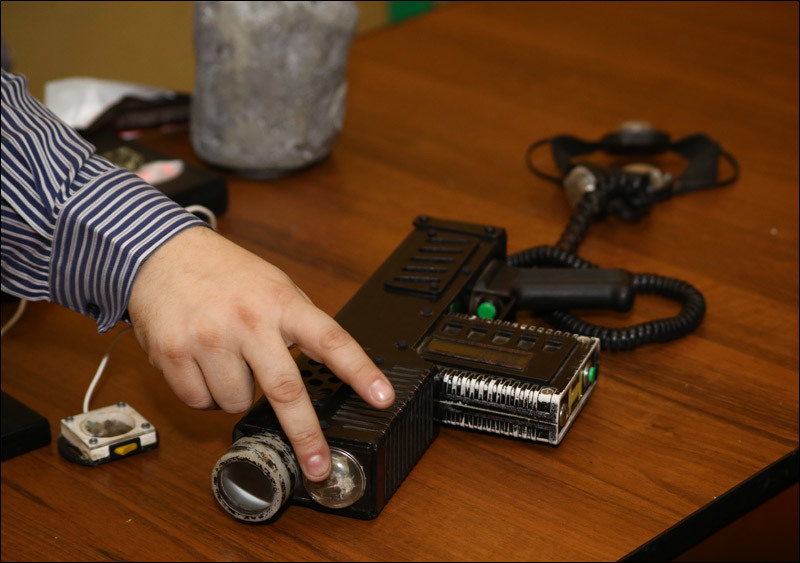
Xotaropuska. Information about the cartridges and hits is displayed on the screen. Recharge here on the button at the bottom, on a shotgun - the usual jerking of the shutter. On the "telephone" wire - hit sensors.
Infrared emitters allowed to make the right hit system, first-aid kits, various mines. "Computer" was in the butt of a shotgun - it showed hits, knew how to take the beam from the first-aid kit and interpret it correctly. Actually, it cost you to run into the hospital to this tricky ray, as you were treated - for the first time automatically, without igrotechnikov.
The same Xotar was seen in the production of related equipment - talking hemp, magic doors with vibration sensors (opened only for a certain rhythm of knocking), locks and much more. UPD: I called him, here .
Cheap arduins and the spread of microelectronics in general brought the third technological level closer.
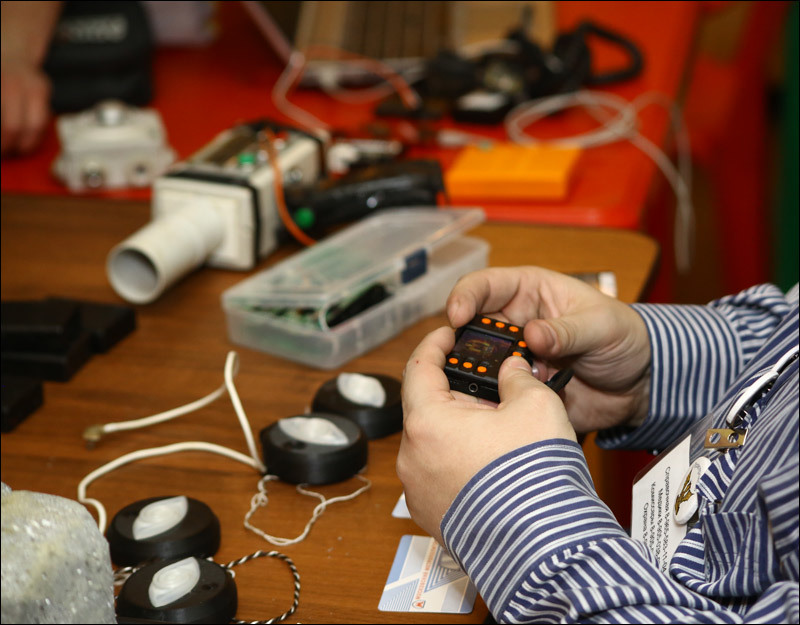
Witcher medallions - monsters are radio emitters, and medallions are receivers. When the monster approaches the wearer, the medallion vibrates. The second application is that each medallion has a button, and when playing a magician when creating a spell, the magicians pressed on it - the others felt that there was a mess somewhere.
Today
I described the peaceful technologies in the report from “Neuronomicon” a little. Locks - on metro cards, the benefit is nothing particularly complicated. Connectivity - a common news aggregator and IRC channels from phones. Payment by cryptocurrency - from a mobile site where each player logs in. Hacking model (third level of connectivity) - right in the browser mini-game for hackers. The forest (more precisely, already a camp site) is now necessarily equipped with electricity and WiFi (if not to a large Internet, then at least to a local server). Many carry laptops and printers, for example, to simulate the activities of the institute on the game or print a document of some office.

Castle
In terms of military items, the best example is the “Ray” PDA system, which was originally developed for “Stalkers” (PDA is a personal anomaly detector). The principle of operation is very, very funny. PDA is a full-fledged computer that has firmware for the current polygon. Fastened to the left hand, charged with AA batteries. On board the main element - the radio.
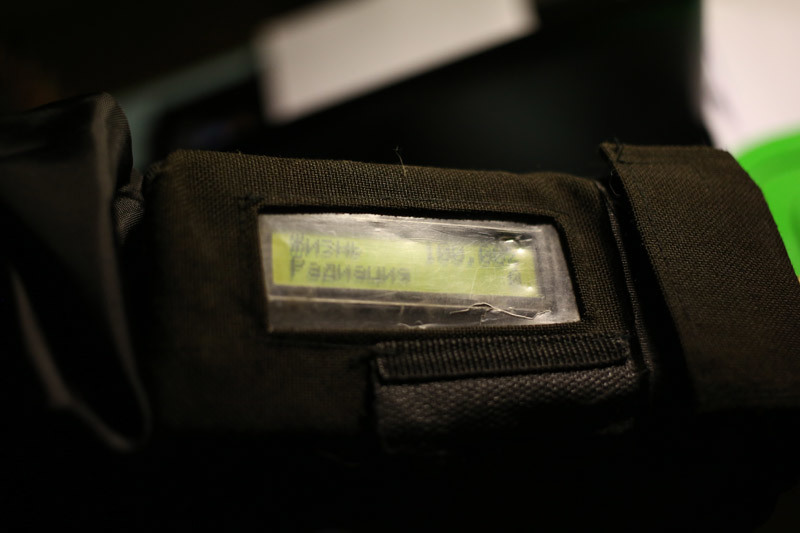
Here it is closer. Under a layer of moisture insulation, there are four well-groped and clearly clicking control buttons that are not accidentally pressed. The first changes the status line (hits / background; anomaly sensor; installed suit and modifications, and so on), then the lights, then all sorts of settings.

But this pipboy in the hands of people
Anomalies are radio emitters with a very small (5-6 meters) or wider (radiation spot 20-50 meters) radius of action.
The possibilities are:
- On the arm, by default, the level of health and radioactive background is shown. When danger of any kind - vibrates.
- When a signal appears, the PDA anomaly receives its number and looks at the firmware, what it is. For example, if it is “frying” that heats a stalker, it shows slow thermal damage and vibrates threateningly. Damage is multiplied by the signal strength - the closer to the center, the stronger. When leaving the anomaly, it does not pass immediately - the firmware simulates a slow burnout. If it is not a fire, but an instant "electra" - then the stalker is likely to immediately go nuts. Moreover, the discharges are modeled either by turning the anomaly signal on or off, or on the firmware — it hits, for example, every seventh second.
- You can insert an SD-stick with a “suit”, “first-aid kit”, “anti-radiation tool” and so on into the PDA. Accordingly, if you walk in a protective suit, the piece of iron on your hand itself reduces the damage (suppose 15% of the protection against fire - and now you have a little more chance to get out of the "frying"). First-aid kits have become disposable: you can write a flag of use to a USB flash drive.
- There is a basic automation - the gradual restoration of health, acting out a radiation contamination (there are prompts that you are with you) and so on. While it is used a little, the symptoms of diseases and reactions to various medications have not reached yet.
- There are other anomalies. For example, an “outlier” (an event affecting everyone in a game) is a radio source at a height that covers the entire polygon (safe places are supplied with smaller radio sources providing protection). The controller carries with itself a transmitter with a radius of 20 meters, which within 2 minutes of being in a radius puts the PDA in the “zombie” status and so on.
All this is richly modified with new firmware. In the end, Stuck adds a new virtual reality around, which, when playing, is not even virtual at all. The detachment goes through the swamp at night, in front - scientists with good PDAs, they look at the background, at the anomalies, plus at dogs and bloodsuckers. After 2 days of the game, an exact map is drawn up in your head - no need to go here, there is “rusty hair” here, there is a “meat grinder” in the building, and wild radiation begins behind that tree. When I returned from Stalker this year, the next day I went to the mall. And it was really difficult for me to break the habit of entering the doorway without looking at my hand.
And the third branch of technology development for transferring to ordinary games has appeared - thanks to the wide distribution of arduine and simple sensors, now there are a lot of different things in quest rooms that behave exactly as they should have been in a quest. For example, here’s a statue from the Crypt quest room:
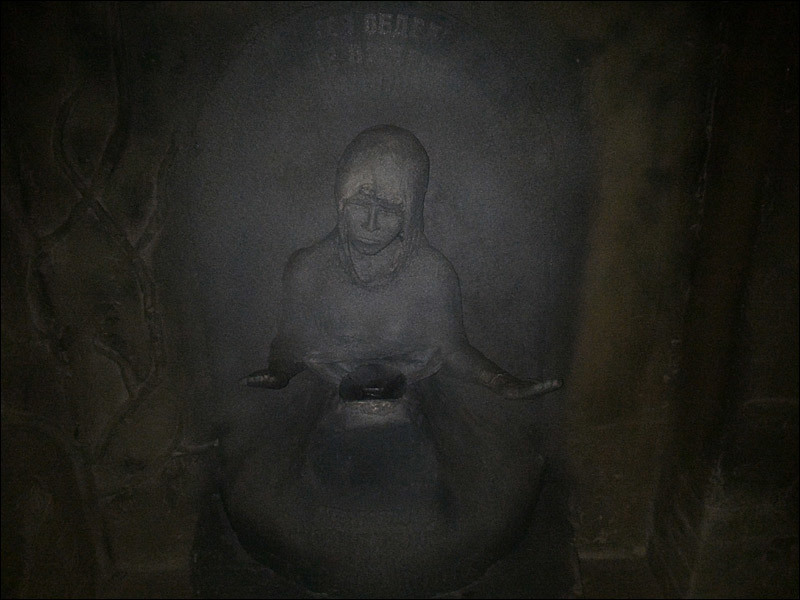
If you take her hands, she will cry. Implemented it is not as beautiful as the face:
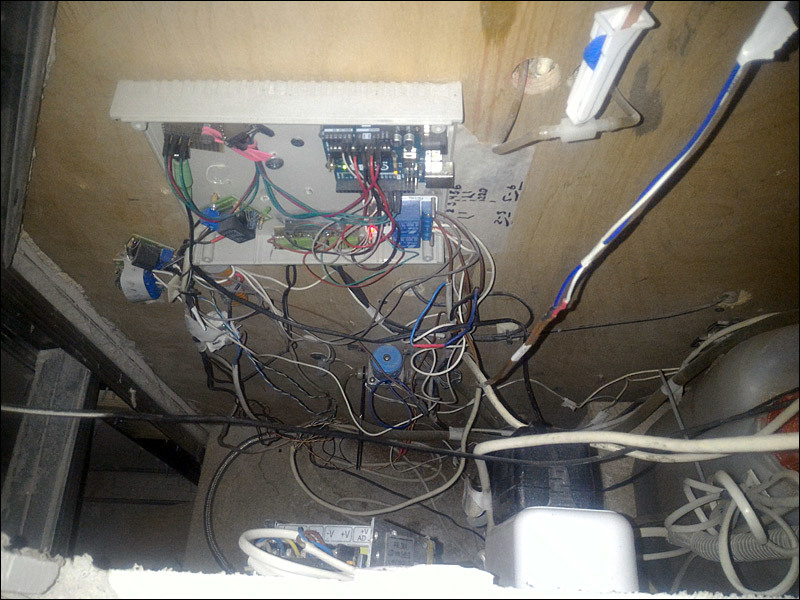
The next stage of modeling creates the possibility of almost direct transfers of many things from imaginary worlds into reality. Especially interesting in this regard are virtualization technologies such as augmented reality glasses and simply 3D glasses. The latter, by the way, were already perfectly tested one-time in games where the “world of spirits” is needed. He came to a point, put glasses on his nose, and read on the wall what he could not see in reality.
Tomorrow
Now a relatively cheap technique allows, in general, to simulate everything that we encounter in games. Plus, the tremendous boom of cosplay, plus the transition of large games like Warhammer to LARP weapons (foamy katanas and swords with a flexible textolite rod) all play on security and, therefore, mass. Previously, modeling was associated with some risk of injury. Modern technologies are mercilessly buggy (but this is normal), but step by step they go to the fact that soon it will be possible to model much of what seemed to be fiction.
On the other hand, it is interesting that many plots are much easier to load into the heads of the players from the computers of games as from sources. For example, in this regard, Stalker is extremely convenient - this is the modern Russian world, where, thanks to automation, the layer of model matching rules almost disappears (PDA writes what happens to you), plus everyone is familiar with the game. Real swamps, real Soviet concrete debris, open hatches in the grass and airsoft combat are attached. And specifying downloads are needed only for such a plan:
- In our game, do not run away from the bloodsucker.
- And why?
- So he's CCM on the run.
Source: https://habr.com/ru/post/306410/
All Articles